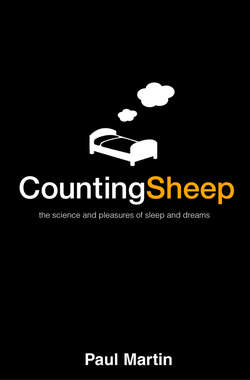Читать книгу Counting Sheep: The Science and Pleasures of Sleep and Dreams - Paul Martin - Страница 39
Measuring sleep
ОглавлениеBrains wave.
Owen Flanagan, Dreaming Souls (2000)
The sleeping brain reveals what is going on inside itself in various ways, both electrically and chemically. Since the middle of the twentieth century, the main tool for monitoring sleep has been the electroencephalograph. This machine exploits the fortunate fact that varying patterns of electrical activity within the brain manifest themselves as varying patterns of voltage changes on the surface of the scalp.
The brain comprises billions of nerve cells, or neurons, and although the electrical activity of an individual neuron is too faint to be detected outside the skull, it is possible to monitor the gross patterns generated collectively by large numbers of neurons. These show up as minute voltage changes, which can be detected by electrodes stuck onto the scalp. (The very first electrodes were small pins that were stuck into the scalps of stoical volunteers.) Thus, the brain emits electrical signals revealing information about its inner state. These tiny voltage patterns are amplified and displayed as the familiar ‘brain waves’ of the electroencephalogram, or EEG. (Confusingly, the machine is called an electroencephalograph, while the graph it produces is called an electroencephalogram, or EEG. To avoid nausea, I will use EEG to denote both the machine and its output.)
The EEG was invented in the 1920s by a psychiatrist named Hans Berger. It really came into its own in the 1950s when, as we shall see, it enabled the discovery of REM sleep. Before the invention of the EEG, scientists could only assess sleep by observing overt body movements, or the lack of them. Scientists still find it useful to record sleepers’ body movements, especially in studies of sleep patterns under natural conditions where the use of EEG would be too intrusive or too expensive. Nowadays, body movements are usually logged automatically, using a miniature recorder worn on the wrist.
Sleep laboratories use an extension of the EEG called the polysomnograph – a sort of somnolent variation on the polygraph. A polysomnograph records the EEG brain waves, together with other informative measures of the sleeper’s physiological state and behaviour. Electrodes placed near the corners of the eyes detect movements of the eyeballs, producing a trace known as the electro-oculogram, or EOG. Other electrodes placed on the chin and neck monitor the muscle tone (producing an electromyogram, or EMG) while electrodes on the chest record the heart rhythms (electrocardiogram, or ECG). Additional devices may record whole body movements, breathing, the flow of air through the nose and mouth, and the concentration of oxygen in the blood. In the early days of sleep science, these measurements were recorded as continuous pen traces on miles of rapidly unfurling paper, but nowadays the outputs are usually stored digitally.
In recent decades, brain scanning has become an increasingly important tool in sleep research. One of the main brain-scanning techniques is called positron emission tomography (PET). PET scans reveal the local patterns of blood flow and oxygen uptake within small areas of the brain by measuring how rapidly the tissue is using energy. Unlike some brain-scanning techniques, PET does not require the subject to sleep inside a large, claustrophobia-inducing scanning device. It therefore allows scientists to monitor sleep under conditions that are slightly closer to normality. Even so, the sleeping subject’s head needs to be kept absolutely still, which is usually achieved by pinning the head down with a special mask (the stuff of some people’s nightmares).
Most measurements of sleep are made in specialised sleep laboratories rather than people’s own homes. The underlying assumption is that the sleep patterns observed in the laboratory closely resemble the real thing. Fortunately, this turns out to be a broadly valid assumption. Comparisons have confirmed that for most people there is a reasonably good concordance between their sleep patterns at home and in the sleep laboratory. But there are some systematic differences. In particular, people tend to sleep for a slightly shorter period under laboratory conditions and to wake up slightly earlier than they would normally. They also have less bizarre dreams and fewer wet dreams. (Wouldn’t you?)
